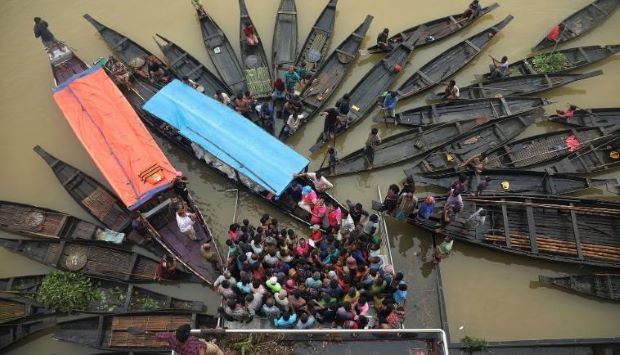Ruinous flooding in India and Bangladesh kills at least 116
By Karan Deep Singh and Saif Hasnat
NEW DELHI — Heavy monsoon rains in India and Bangladesh have flooded an airport and knocked down cellphone towers, bridges and power lines, cutting off communications for millions of people and forcing the evacuation of hundreds of thousands.
At least 116 people have been killed in the flooding and lightning strikes, as well as in landslides, which have made rescue operations even more difficult, according to officials.
This latest catastrophic flooding comes less than a month after extreme rainfall submerged towns, causing widespread misery in the region.
On Monday (20), officials in Assam, a state in northeastern India bordering Bangladesh, said all the state’s 33 districts were affected by the floods, which they blamed for undoing almost a decade of progress on building roads, bridges and other infrastructure connecting far-flung towns and villages dotted across the state’s lush green mountains. At least 73 people have died as a result of the disaster in the state, according to news reports.
More than 400 rescuers have been deployed in the state, said H.P.S. Kandari, a commander with India’s National Disaster Response Force.
In the neighbouring state of Meghalaya, extremely heavy rainfall pummelled the towns of Cherrapunji and Mawsynram, in one of the wettest regions in the world. On Friday (17), Mawsynram recorded about 40 inches of rainfall in a single day, one of the wettest in June since 1966. In the Dangar area nearby, at least five people in one family were killed in a landslide Monday, Conrad Sangma, the state’s chief minister, said on Twitter.
The record-shattering rain in the state has also led to extensive flooding across the border in Bangladesh, where rivers were already overflowing. “We haven’t seen such rainfall in many, many years,” said Tarekul Islam, a professor at the Institute of Water and Flood Management at the Bangladesh University of Engineering and Technology in Dhaka, the capital.
Islam said the heavy rainfall flooded the country’s Sylhet region, one of the worst affected since last month, when the floodwaters of the Brahmaputra and other rivers broke their banks and inundated large parts of the low-lying nation of about 170 million people.
Since the May flooding, more than 4 million people in northeastern Bangladesh have been left homeless, including 1.6 million children, said the United Nations Children’s Fund in a news release Monday. “Children need safe drinking water right now,” said Sheldon Yett, UNICEF’s representative to Bangladesh. “Preventing deadly waterborne diseases is one of several critical concerns.”
At least 38 people have died in Bangladesh because of the latest flooding, according to the Foundation for Disaster Forum, a Dhaka-based nonprofit working to provide food and shelter to people in Sylhet. Days of rainfall and flooding have knocked down mobile phone towers and forced authorities to snap power lines to prevent electrocution.
Selim Miah, a farmer who lives in the Gowainghat subdistrict of Sylhet, said his home was washed away by the floods.
All his 10-member family had at the moment, he said, was some puffed rice, molasses and a 2-liter bottle of drinking water, which relief workers had provided.
“I have never seen an extensive flood like this,” Miah, 29, said. “When the floodwater entered our living room, we put everything we had on top of the tin roof, including our cattle. But we could not stay like that because the water also reached the roof.”
Over the weekend, with the power lines still down, Bangladesh’s health ministry ordered officials in Sylhet to provide critical electricity support to the Sylhet M.A.G. Osmani Medical College, one of the main hospitals in the region, by using diesel-powered generators.
One of Bangladesh’s largest airports, the Osmani International Airport in Sylhet, was still flooded Monday after rainwater forced officials to cancel all flights Friday.
Bangladeshi officials said Monday that hundreds of thousands of people had been forced to leave their homes because of the floods and that they were trying to rescue those who were still stranded.
“We have evacuated more than 300,000 people who were marooned,” said Mosharraf Hossain, a government official in the Sylhet region. “Many of them have lost their houses made of tin and bamboo.”
-New York Times


